

Improving Business Efficiency with Technology. Improving Business Efficiency with Technology 5.00/5 (100.00%) 4 votes Starting a company with technology helps can be simple, the hardest part can actually be maintaining that company’s reputation.
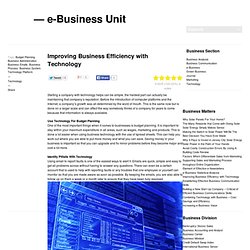
Before the introduction of computer platforms and the Internet, a company’s growth was all determined by the word of mouth. This is the same now but is done on a larger scale and can affect the way somebody thinks of a company for years to come because that information is always available. Use Technology For Budget Planning One of the most important things when it comes to businesses is budget planning.
It is important to stay within your maximum expenditure in all areas, such as wages, marketing and products. Let Your Employees Know Their Duties All equipment needs maintaining but it can be difficult to do everything yourself. Combining Technology with Business – Cost Savings and Efficiency. Combining Technology with Business – Cost Savings and Efficiency 5.00/5 (100.00%) 2 votes Using technology is not just about running a website for your company, although that is a good start.
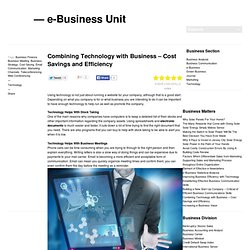
Depending on what you company is for or what business you are intending to do it can be important to have enough technology to help run as well as promote the company. Technology Helps With Stock Taking One of the main reasons why companies have computers is to keep a detailed list of their stocks and other important information regarding the company assets. Using spreadsheets and electronic documents is much easier and faster; it cuts down a lot of time trying to find the right document that you need. There are also programs that you can buy to help with stock taking to be able to alert you when it is low.Technology Helps With Business Meetings Phone calls can be time consuming when you are trying to through to the right person and then explain everything. Using Technology to Improve Efficiency in the Workplace.
Marketing: How technology can increase efficiency - by Leigh Goessl. Leigh Goessl's image for: "Marketing how Technology can Increase Efficiency" Caption: Location: Image by: Information systems have become a driving force in today's business environments.
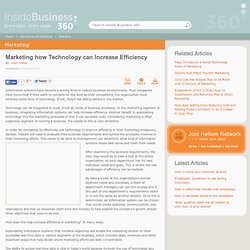
Technology can be integrated in most, if not all, kinds of business processes. In order for companies to effectively use technology to improve efficiency in their marketing endeavors, decision makers will need to evaluate their business requirements and outline the processes involved in their marketing efforts. After examining the business requirements, the next step would be to take a look at the entire organization, as each department has its' own individual needs and goals. "To remain competitive in an increasingly competitive world, businesses must boost operational efficiency wherever possible. The following are 10 tips for using network technology to help your business increase operational efficiency, reduce costs, improv.
Helps Customers Achieve New Levels of Efficiency with Enhanced Systems Management Capabilities and Refreshed PowerEdge Server Portfolio. How technology can increase efficiency in a business. Social Networks Improve Business Performance - Technorati Advertising. McKinsey says that social networks are “extending the organization;” that’s a key take-away from their fifth annual study of the use of technology in organizations.
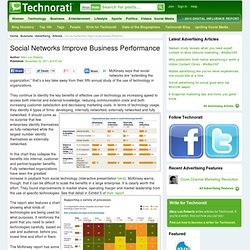
They continue to identify the key benefits of effective use of technology as increasing speed to access both internal and external knowledge, reducing communication costs and both increasing customer satisfaction and decreasing marketing costs. In terms of technology usage, they identify 4 types of firms: developing, internally networked, externally networked and fully networked. It should come as no surprise that few enterprises identify themselves as fully-networked while the largest number identify themselves as externally networked. In this chart they collapse the benefits into internal, customer and partner/supplier benefits. The report also features a chart showing what kinds of technologies are being used for what purposes. The McKinsey report has some data on adoption of technology by industry. Mobile Technology: A Means To Improve Operational Efficiency. Could Help Desk Software Improve The Efficiency Of Your Business?
Enterprise resource planning. Picture showing some typical ERP modules Enterprise resource planning (ERP) is a business management software—usually a suite of integrated applications—that a company can use to collect, store, manage and interpret data from many business activities, including: Product planning, costManufacturing or service deliveryMarketing and salesInventory managementShipping and payment ERP provides an integrated view of core business processes, often in real-time, using common databases maintained by a database management system.
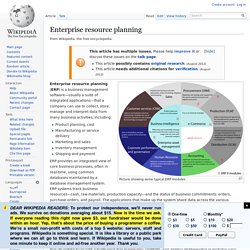
ERP systems track business resources—cash, raw materials, production capacity—and the status of business commitments: orders, purchase orders, and payroll. The applications that make up the system share data across the various departments (manufacturing, purchasing, sales, accounting, etc.) that provide the data.[1] ERP facilitates information flow between all business functions, and manages connections to outside stakeholders.[2] History[edit] Online analytical processing. In computing, online analytical processing, or OLAP /ˈoʊlæp/, is an approach to answering multi-dimensional analytical (MDA) queries swiftly.[1] OLAP is part of the broader category of business intelligence, which also encompasses relational database, report writing and data mining.[2] Typical applications of OLAP include business reporting for sales, marketing, management reporting, business process management (BPM),[3] budgeting and forecasting, financial reporting and similar areas, with new applications coming up, such as agriculture.[4] The term OLAP was created as a slight modification of the traditional database term OLTP (Online Transaction Processing).[5] OLAP tools enable users to analyze multidimensional data interactively from multiple perspectives.
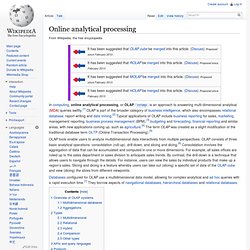
Sales and operations planning. Sales and operations planning (S&OP) is an integrated business management process developed in the 1980s by Oliver Wight[1] through which the executive/leadership team continually achieves focus, alignment and synchronization among all functions of the organization.

The S&OP planning includes an updated forecast that leads to a sales plan, production plan, inventory plan, customer lead time (backlog) plan, new product development plan, strategic initiative plan and resulting financial plan. Plan frequency and planning horizon depend on the specifics of the industry. Short product life cycles and high demand volatility require a tighter S&OP planning than steadily consumed products. Done well, the S&OP process also enables effective supply chain management. A properly implemented S&OP process routinely reviews customer demand and supply resources and “re-plans” quantitatively across an agreed rolling horizon.